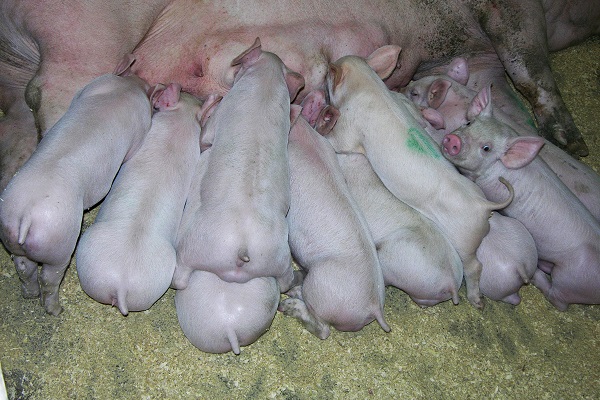

Farmers need to recognize there will always be health challenges in Piggery. The goal is to resolve those challenges as they arise and not let them become a gradual increase of endemic disease that makes antibiotic-free production untenable. Therefore, the decision to enter into pig production without the use of antibiotics should not be made lightly.
Below are key factors that drive success in hog production when not using antibiotics.
High health status
Breeding stock and pig flow should be negative for these diseases: porcine reproductive and respiratory syndrome virus, porcine epidemic diarrhea virus/porcine delta coronavirus, actinobacillus pleuropneumonia and swine dysentery.
Other disease such as Mycoplasma hyopneumoniae (M. hyo) and influenza A (IAV) are ideally excluded from pig flow but are more easily managed with vaccination than other diseases.
Strict biosecurity
Excellent biosecurity is needed to prevent disease introduction. If the most severe diseases are kept out, other endemic diseases are more easily managed through a combination of appropriate gilt acclimation, vaccination protocol, pig flow and husbandry.
Gilt acclimation
When possible, use replacement stock from the same source used to originally populate the barn. Gilt facilities on breeding farms should allow a 2- to 4-month acclimation period when diseases like IAV and M. hyo are present. Internal development of replacement animals is a good way to manage exposure and acclimation of replacement stock, as long as external disease introduction is minimized.
Vaccination
A vaccination program that creates a diverse, robust immunity is key to preventing the emergence of disease. Vaccinations should address all endemic diseases present in the breeding herd and pig flow, as well as diseases that the pigs will likely encounter downstream. Breeding herd vaccinations should include porcine circovirus type 2 (PCV2), M. hyo, influenza, parvovirus/leptospirosis/erysipelas, Haemophilus parasuis and Salmonella.
Growing pigs should be vaccinated against PCV2 and M. hyo along with ileitis. Additional vaccinations frequently are necessary to control Salmonella, E. coli, erysipelas, Pasteurella/Bordetella and IAV. Vaccination protocols should maximize immune response. This means vaccinating at the correct age with full doses and using two-dose protocols when necessary and recommended.
All-in, all-out pig flow
Using batch farrowing on sow farms and all-in, all-out pig flows on grow-out sites to allow the elimination of diseases that emerge in the normal course of production.
Large populations impact health, too therefore, setting up systems to minimize the number of pigs at one site without sacrificing the economies of scale needs to be sustainable. Sow farms should be kept at 1,400 head or less and on a 4- or 5-week batch system with each group flowing to distinct grow-out sites that are emptied after each turn.
Barns designed for comfort
Barns used for raising pigs without antibiotics must allow for optimal husbandry conditions. Proper ventilation and temperature regulation are critical in preventing environmental stressors that can predispose pigs to disease. Use zone heating, mats, hovers, etc., to manage the micro-environment for pig comfort. Water systems should allow routine use of oral vaccines and supplements. Water treatment systems may be needed in some areas to control pH and bacteria. Smaller, conventional penning with 20 to 30 pigs per pen is better than large pen designs.
Producer engagement
Producer engagement is key to the success of the growing pigs, particularly in the nursery phase. Careful attention to requirements for environmental management and for individual pig care are required in order to optimize success. Farmers should ensure to train animal caretakers take high priority. The time and resources invested in training will help keep caretakers engaged and motivated.
Veterinary oversight
Veterinarians have a key role to play in pig systems not using antibiotics. Prompt, accurate diagnosis of disease challenges and timely, targeted treatment can often prevent the need for mass medication. Responsibility for this oversight cannot rely on lay staff. Veterinarians have training and expertise that allows them to view the big picture and identify not just the disease challenges present but also the factors that predispose those diseases.
 Contact Jaguza Support
Contact Jaguza Support